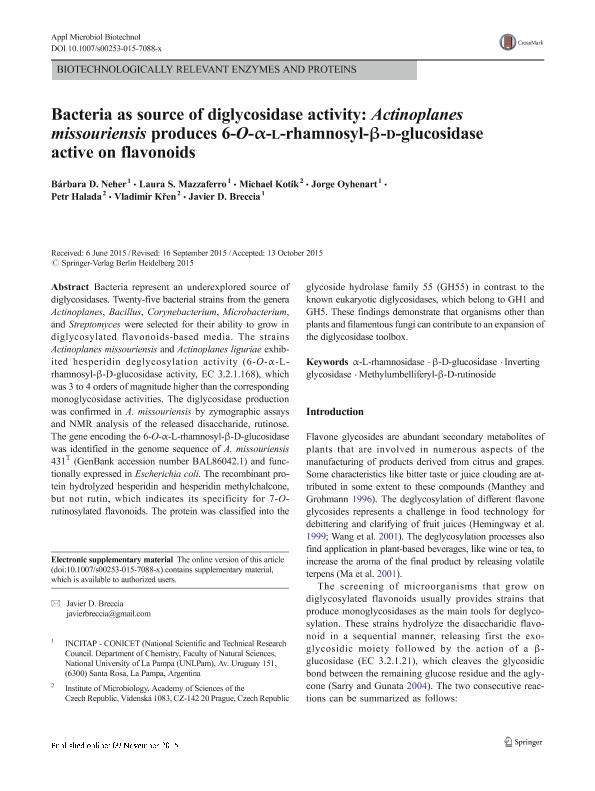Artículo
Bacteria as source of diglycosidase activity: actinoplanes missouriensis produces 6-O-α-l-rhamnosyl-β-d-glucosidase active on flavonoids
Neher, Bárbara Daniela ; Mazzaferro, Laura
; Mazzaferro, Laura ; Kotik, Michael; Oyhenart, Jorge
; Kotik, Michael; Oyhenart, Jorge ; Halada, Petr; Breccia, Javier Dario
; Halada, Petr; Breccia, Javier Dario ; Křen, Vladimír
; Křen, Vladimír
 ; Mazzaferro, Laura
; Mazzaferro, Laura ; Kotik, Michael; Oyhenart, Jorge
; Kotik, Michael; Oyhenart, Jorge ; Halada, Petr; Breccia, Javier Dario
; Halada, Petr; Breccia, Javier Dario ; Křen, Vladimír
; Křen, Vladimír
Fecha de publicación:
11/2015
Editorial:
Springer Heidelberg
Revista:
Applied Microbiology and Biotechnology
ISSN:
0175-7598
e-ISSN:
1432-0614
Idioma:
Inglés
Tipo de recurso:
Artículo publicado
Clasificación temática:
Resumen
Bacteria represent an underexplored source of diglycosidases. Twenty-five bacterial strains from the genera Actinoplanes, Bacillus, Corynebacterium, Microbacterium, and Streptomyces were selected for their ability to grow in diglycosylated flavonoids-based media. The strains Actinoplanes missouriensis and Actinoplanes liguriae exhibited hesperidin deglycosylation activity (6-O-α-L-rhamnosyl-β-D-glucosidase activity, EC 3.2.1.168), which was 3 to 4 orders of magnitude higher than the corresponding monoglycosidase activities. The diglycosidase production was confirmed in A. missouriensis by zymographic assays and NMR analysis of the released disaccharide, rutinose. The gene encoding the 6-O-α-L-rhamnosyl-β-D-glucosidase was identified in the genome sequence of A. missouriensis 431T (GenBank accession number BAL86042.1) and functionally expressed in Escherichia coli. The recombinant protein hydrolyzed hesperidin and hesperidin methylchalcone, but not rutin, which indicates its specificity for 7-O-rutinosylated flavonoids. The protein was classified into the glycoside hydrolase family 55 (GH55) in contrast to the known eukaryotic diglycosidases, which belong to GH1 and GH5. These findings demonstrate that organisms other than plants and filamentous fungi can contribute to an expansion of the diglycosidase toolbox.
Archivos asociados
Licencia
Identificadores
Colecciones
Articulos(INCITAP)
Articulos de INST.D/CS D/L/TIERRA Y AMBIENTALES D/L/PAMPA
Articulos de INST.D/CS D/L/TIERRA Y AMBIENTALES D/L/PAMPA
Citación
Neher, Bárbara Daniela; Mazzaferro, Laura; Kotik, Michael; Oyhenart, Jorge; Halada, Petr; et al.; Bacteria as source of diglycosidase activity: actinoplanes missouriensis produces 6-O-α-l-rhamnosyl-β-d-glucosidase active on flavonoids; Springer Heidelberg; Applied Microbiology and Biotechnology; 100; 7; 11-2015; 3061-3070
Compartir
Altmétricas



